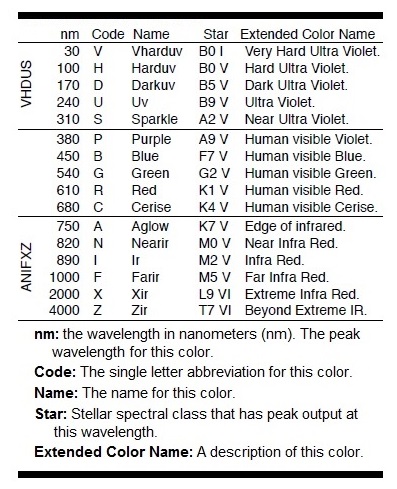Electromagnetic Spectrum
The Electromagnetic Spectrum is a graphic representation of the entire range of frequencies, or spectrum, of electromagnetic radiation.
- It is normally abbreviated to EM Spectrum.
Description (Specifications)
Electromagnetic radiation consist of two waves oscillating perpendicular to one another. One of the waves is an oscillating magnetic field; the other is an oscillating electric field. Electromagnetic radiation can be produced in a number of different ways:
- Electromagnetic radiation is commonly produced by accelerated electric charges, with frequencies corresponding to the magnitude of the acceleration.
- Electromagnetic radiation is likewise both absorbed and emitted by quantum mechanical systems in bound states when a transition occurs from one energy state to another.
- Electromagnetic radiation is also absorbed and emitted thermally by materials as blackbody radiation in equilibrium with their environment, with higher temperature corresponding to higher radiation frequency.
Regardless of source, these waves interact with matter and produce differing results depending upon wavelength.
The electromagnetic spectrum is a continuous range of wavelengths. This spectrum includes high energy Gamma and X-rays, visible light, and various radio wave frequencies. The types of radiation that occur in different parts of the spectrum have different uses and dangers, depending on their wavelength and frequency.
- Radio waves have the lowest frequencies and longest wavelengths, while gamma rays have the highest frequencies and shortest wavelengths.
All of these waves travel at the same speed within the vacuum of space (the speed of light – about 300,000 km per second).
Image Repository
The electromagnetic spectrum manifests electromagnetic waves with frequencies ranging from below one hertz to above 1025 hertz, corresponding to wavelengths from thousands of kilometers down to a fraction of the size of an atomic nucleus. The EM Spectrum is traditionally divided into a number of specific named frequency ranges that are further subdivided into groupings of separately named bands within the range by frequency. These frequncies are encountered in a number of common contexts, and have a variety of practical applications.
Range:
- Radio waves. The interaction of Radio waves with matter generates tiny electrical charges. Common uses include radio communications and television signals
- Microwaves. The interaction of microwaves with non-conductive matter produces heat. Conductors will strongly absorb microwaves, causing electric currents and heating the material. Common uses include food preparation and cellphone signals. The Universe radiates "heat" as a background in the microwave range corresponding to a blackbody temperature of 2.7 K, a residual leftover from its creation 13.8 billion years ago as it continues to cool.
- Infrared. What is commonly considered a suitable living environment for most sophonts, including "room temperature" for humans, radiates heat, or "glows", thermally in the infrared band. Common uses of this band include vision enhancement devices and optical fiber systems. Some creatures and sophonts have natural vision extending into this range.
- Visible light. – natural vision of humans and many sophonts and sentient creatures.
- Ultraviolet. Common uses include "convenience" sensors, such bioscans and detecting forged currency. Ultraviolet radiation is the first range of bands energetic enough to ionize atoms by removing electrons and thus cause or alter chemistry; therefore, it and the higher frequency ranges are sometimes referred to as "ionizing radiation". Some creatures and sophonts have natural vision extending into this range.
- X-rays. Common uses include medical imaging of internal structures. X-rays are often produced as a by-product of many high energy systems.
- Gamma rays. Common uses include killing cancerous cells. Gamma rays are often produced as a by-product of very high energy systems, including power and weapon systems.
History & Background (Dossier)
A detailed understanding of the electromagnetic spectrum begins with the development of precise scientific instruments.
- Modern sensor systems are used to detect and analyze portions of the EM spectrum.
Visual Perception
Humans form the baseline for visual perception of the electromagnetic spectrum: it is perceived as colors.
Different organisms, with different senses, can perceive different regions of the spectrum compared to humans, also seeing these different frequencies of energy as unique colors. This is extremely common - even Terran creatures, native to the human homeworld, can see further into the infrared or ultraviolet than humans. Other species of creatures and sophonts, originating on worlds orbiting different types of stars and having evolved in radically different environments and conditions, may have the ability to view more extreme regions of the spectrum.
Data Repository
Vision: an overview of colors. 
- Note: See metadata page.
Except for a few gifted sophont species, most NILs lack the bodily ability to sense more than a very limited part of the electromagnetic spectrum. As technology develops, particularly in relation to the construction of electronics in the TL:7-9 technological epoch, sophonts create sophisticated devices to sense that which their bodies cannot and translate that data into information that they can. [1]
References & Contributors (Sources)
| This article has metadata. |
- Marc Miller. T5 Core Rules (Far Future Enterprises, 2013), TBD.
- Traveller Wiki Editorial Team
- Author & Contributor: Lord (Marquis) and Master Scout Emeritus Adie Alegoric Stewart of the IISS
- Author & Contributor: Lord (Marquis) and Master of Sophontology Maksim-Smelchak of the Ministry of Science
- ↑ Information provided to the library by Maksim-Smelchak

